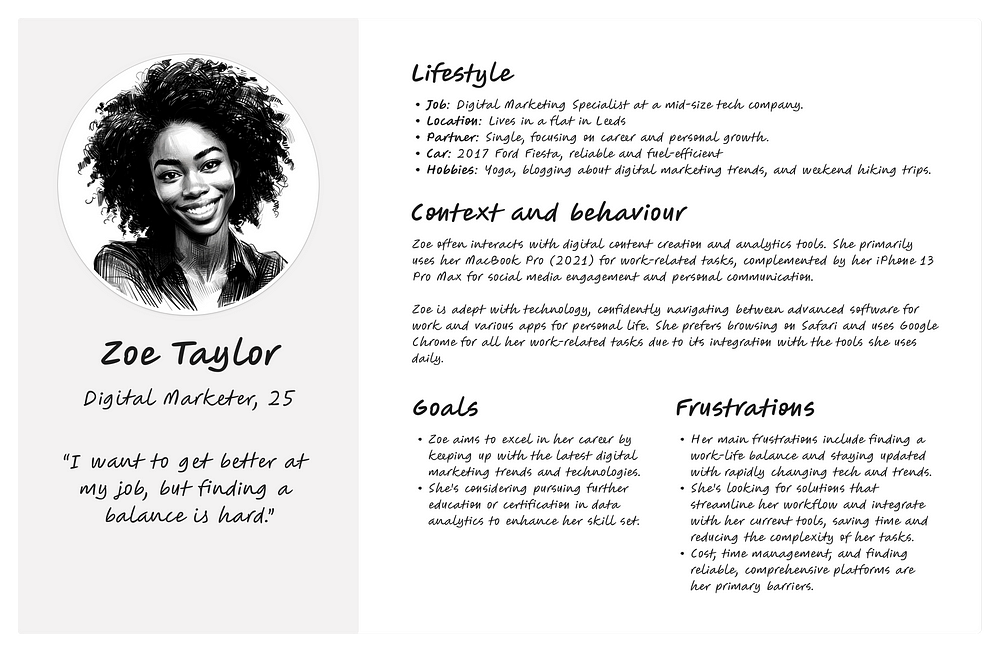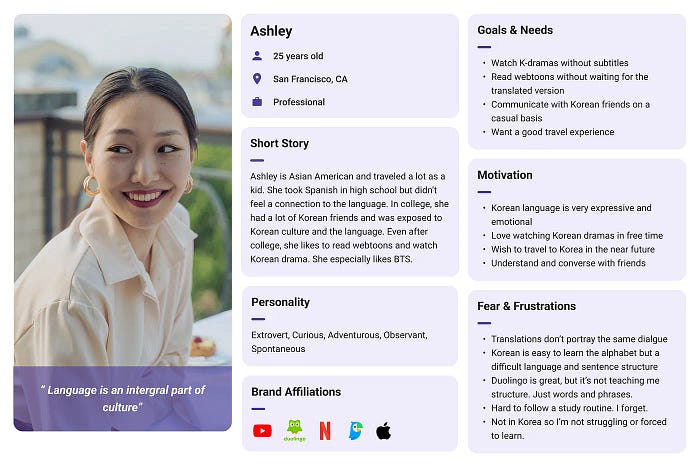

User personas: how they started, and how they’re going
source link: https://uxplanet.org/user-personas-how-they-started-and-how-theyre-going-7160a5dbf845
Go to the source link to view the article. You can view the picture content, updated content and better typesetting reading experience. If the link is broken, please click the button below to view the snapshot at that time.
User personas: how they started, and how they’re going
What’s the story with personas — and do they actually work?

Introduction
Whenever I talk to project stakeholders about personas, I usually get sceptical looks. Wait, we’re going to make up fictional characters who use our website? Why?
Yet despite looking like a creative indulgence, user personas are incredibly useful and important.
At least, that’s what designers would have you believe.
But are they useful? What are the reported benefits of personas? What’s the current thinking on them?
We’ll get into that, but first let’s cover basics: what personas are, why they’re used, how to create them and where they came from.
What are user personas?
A persona is a fictional, yet realistic, description of a typical or target user of the product
The important thing to remember here is that user personas represent a type of user.
They’re not a real person — hence the ‘fictional’ bit — but they should be written as if they’re an actual individual.
Why? Because the purpose of personas is to empathise with the people you’re designing for, to understand them and design better to meet their needs. That’s easier to do when you’ve got 29-year old Gavin from Suffolk in mind than ‘users’ in the abstract sense.

Personas aren’t completely made up — they should be based on real research. For example website analytics can tell you the content people are interested in, as well as where, when and on what devices they access it. Combine that with themes from surveys, focus groups or user interviews and some personas will start coming to mind.
Tip: Avoid the temptation to use too much from a single real individual in your personas. It’ll lead you down the path of designing for literally one person and all their quirks and idiosyncrasies.
What to include in personas
There’s no universal agreement about what a persona should include, and not all of the personas I’ve designed have followed the same format. But here are some suggestions:
- Photo, name, job and age — These details instantly make the persona feel like the profile of a real person. You can generate a profile image using AI tools, or crawl stock photo sites for something that feels right.
- Quote — This is a useful technique to help encapsulate a persona in one-line summary. (This could be a real thing someone said in a survey or interview that neatly represents a type of user.)
- Lifestyle — List some details to flesh out your persona, e.g. career, location, partner, children, car, hobbies, etc. Be precise — say they drive a ‘2017 Ford Fiesta’ rather than a ‘second-hand car’. Avoid too many extraneous details that won’t impact the design.
- Context and behaviour — Explain how the persona would interact with your product, what devices they use and the level of experience and confidence they have with each. Again, aim for precision — say they have ‘an iPhone 13 Pro Max’ rather than simply ‘a smartphone’.
- Goals and frustrations — These bits are sort of like proto-requirements. What is your persona trying to do? Why would they use your product? Explain the barriers they face, e.g. cost, time, accessibility, etc. These things can develop empathy, clarify the problems to solve and prompt creative ideas.
Following this approach, you’ll be able to sketch out a basic user persona that looks like the one below. Once you’re happy with it, you can put the content into the design template for your project’s personas.

You can keep evolving your personas throughout the project — they can be updated as you continue researching and learning new things. It’s also okay to add new entire personas during a project, and remove or de-prioritise existing personas as needed.
Finally, I mentioned before that there’s no absolute consensus on exactly what personas should include — below is a good example with an alternative format from Christina Sa’s excellent case study for a language learning app.

Personas as an evaluation tool
You can test product designs — including wireframes or interactive prototypes — against your personas using processes most designers will already be familiar with, such as:
- usability testing
- semi-structured interviews
- expert verification — like a heuristic evaluation of a design, but focused on whether they stack up against the personas you’ve created
Tip: There’s a common idea that you should have ‘fewer than 10’ personas to keep things simple. But studies have suggested that designing up to 15 personas doesn’t lead to more confusion or less empathy.
How personas started
The agreed starting point for user personas in software development is Alan Cooper’s 1999 book The Inmates are Running the Asylum (which is a title you probably couldn’t get away with using these days).

In his book, Cooper outlines why we should use personas, arguing they increase the focus on users and their goals, facilitate effective communication about users, and reduce changes needed at the end of the development process.
At the time, this idea of designing for individual personas seemed revolutionary, but Cooper and his company had been doing it for years.
We can now see that persona-based design is actually a facet of design thinking and human-centred design, which emphasises the importance of empathy and focus on the experience of using a product.
There are some fascinating ideas in Cooper’s book, including:
- Precision over accuracy — No one has 2.3 children, so even though using an average is technically more accurate in representing your type of user, for a persona we would state they have 2 or 3 kids.
- Credence over diversity — Cooper argues it’s ok for a persona to be stereotypical, as it’s more important for them to be believable than diverse, e.g. if you’re designing a product for nurses, it’s okay for the primary persona to be female.
- Ending feature debates — For example, there’s no need to include a ‘print this page’ option if your primary persona is Zoe and she doesn’t care about printing the page. It doesn’t matter if some user, somewhere, might want to print the page. Because you’re not designing for ‘some user’. You’re designing for Zoe.
What are the benefits of personas?
If we think of user personas as having started with Alan Cooper in 1999 and that they’ve been around for about 25 years, then this 2011 study from Miaskiewicz and Kozar about the benefits of using personas in product design was a bit like a half-term report card.
In the above study, the researchers did a meta-analysis of different papers that discussed user personas and their advantages. In addition to Cooper’s suggested benefits a lot of other positives were recorded, including that personas:
- build empathy for users
- make the user needs more explicit
- define the product’s feature set
- lead to better design decisions (e.g. ending feature debates)
- help to measure a design’s effectiveness
- increase engagement among the design team
- support related efforts such as marketing plans
Tip: User and marketing personas are different things; one is concerned with how someone needs to usethe product, the other is focused on who’ll buy it — they can be very different people, especially with business software.
Miaskiewicz and Kozar ranked these benefits of user personas by importance. Of the 22 themes, the top benefits were:
- Focus on users/customers and their goals (not limitations or opportunities presented by technology)
- Prioritisation of the audience and the product requirements — are the right problems being solved for the right people?
- Challenging (possibly long-standing) assumptions about who an organisation’s users/customers actually are
- Prevention of “self-referential” design — emphasising how personas help distinguish the users from the product designers (i.e. don’t design for yourself)
What’s the current thinking on personas?
A systematic review of user personas in 2022 found a lot of the same benefits as the half-term report, but it also observed that personas are increasingly being used across a lot more sectors and industries.
As you’d expect, software development tops the table for persona use cases. User personas are still somewhat synonymous with UX design and digital products. But they’re increasingly being used across areas such as healthcare, higher education and marketing.
Not only that, but there’s evidence of them being used for ‘social good’ in addition to ‘business interests’. This means personas are no longer simply assets on the road to creating products people will buy. They’re a tool to carry out public services and worthy initiatives to a target audience.
So it’s also clear that personas have matured, diversified, and are no longer the preserve of UX designers getting evangelical about human-centred design.
Yet there’s also a problem with personas. One that’s been known for many years: there’s technically no evidence they actually work.
Oh, there’s data — from interviews, surveys, but it’s all self-reporting from professionals using personas to design products or services. However, there’s a distinct lack of scientific methodology to back up the purported benefits of personas as a design tool.
The 2022 study describes it like this:
“Corroborating the impact of persona use mainly relies on anecdotes instead of rigorous empirical testing or even systematically conducted case studies.”

Measuring the impact of personas
One of the suggestions of the 2022 study is for future research to explore how to “isolate the effect of personas as a design instrument relative to other methods” adding “for addressing this question, we recommend controlled experiments”.
Controlled experiments. What could that look like? I suppose we could essentially A/B test small, identical digital projects in which personas are either used (the experimental group) or not used (the control group) and the results of the project compared. You could replicate this approach many times and analyse the impact of persona use on the outcome of the projects in an objective way.
The obvious problem with this approach is that it’s doing the same project twice, potentially doubling factors like cost and resources required. But it’s something UX designers should be open to to learn more and add credibility to their methods.
Conclusion
In a nutshell:
- User personas are an established part of the UX design process, and are now used across many industries.
- Everyone who uses personas places high value on them, and report lots of benefits. But there’s no solid science to support those claims.
- That doesn’t mean we should stop using or advocating for personas. I strongly argue for them on projects, and will continue to do so as I believe in the benefits.
- But as UX design professionals, we should be mindful that a lot more work is still needed to show us how well they work and how to best use them.
Sources
Burton, L. (2022) What are personas, and what are they used for? Available at: https://www.uxdesigninstitute.com/blog/what-are-ux-personas/ (Accessed: 22 March 2024).
Cooper, A. (1999) The inmates are running the asylum. Indianapolis, Ind.: Sams.
Dahekar, M. (2023) A guide to creating UX personas. Available at: https://medium.com/@mahimadahekar/a-guide-to-creating-ux-personas-677ad5bbdc8a (Accessed: 22 March 2024).
Kaplan, K. (2022) Personas: study guide. Available at: https://www.nngroup.com/articles/personas-study-guide/ (Accessed: 22 March 2024).
Miaskiewicz, T., and Kozar, K. A. (2011) ‘Personas and user-centred design: How can personas benefit product design processes?’, Design Studies, 32(5). Available at: https://doi.org/10.1016/j.destud.2011.03.003
Salminen, J., Guan, K. W., Jung, S. G., and Jansen, B. (2022) ‘Use cases for design personas: a systematic review and new frontiers’, Proceedings of the 2022 CHI Conference on Human Factors in Computing Systems (CHI ‘22). Association for Computing Machinery, 543, pp. 1–21. Available at: https://doi.org/10.1145/3491102.3517589
Icon credits: Freepik and Gregor Cresnar.
About the author
Andrew Tipp is a lead content designer and digital UX professional. He works in local government for Suffolk County Council, where he manages a content design team. You can follow him on Medium and connect on LinkedIn.
Recommend
About Joyk
Aggregate valuable and interesting links.
Joyk means Joy of geeK